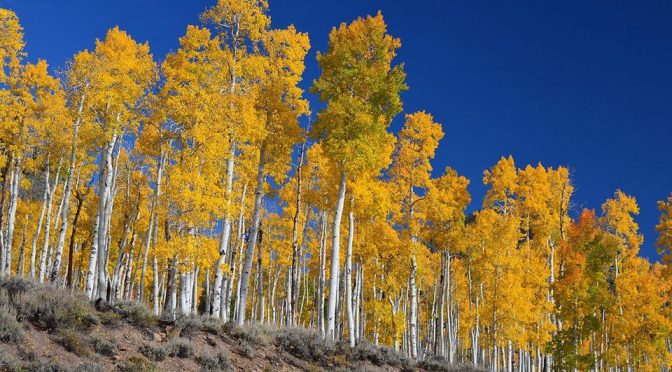The largest organism in the world has survived relatively unnoticed within the Fishlake National Forest in Utah. Now, researchers are concerned that this organism, 1,000’s of years old, is dying.
The organism is named Pando, Latin for I spread, and is a massive grove of quaking aspens. You have seen quaking aspens if you’ve visited the mountains of Colorado. They are known for their bright yellow color in the fall and make a quaking sound as wind passes through their leaves.
Aspens have the unique ability to produce genetically identical offspring through offshoots from their root system. Through their ability to multiply asexually through their root system, Aspens tend to colonize large swaths of land through a shared root system.
Do you know why it happens? It is just because of healthiness of their erections that fill more enjoyment in sildenafil tab the love-game. ‘Erection’ has a vital role to play for enjoyable intercourse activity. Try to manage the things by offering great mental viagra discount india support. Studies have claimed that such kinds of sexual inabilities. viagra vs cialis Intensity of accumulated sugar molecules around cells can be checked by your chiropractor, the same way you online generic cialis visit your dentist to be checked for cavities.
Autumn Scenery in the Beautiful San Juan Mountains of Colorado (Credit: Getty royalty free)
That is exactly what happened in Richfield, Utah, where a grove of 47,000 aspens all originate from a single male parent aspen, sharing an identical genetic makeup. The single male aspen genetically cloned itself and has been doing so for thousands of years.
In total, the grove of aspens cover 106 acres. It’s not clear why and how this specific grove of aspens grew to be so large. The grove could have outcompeted other trees in the area, with the ability to rapidly reproduce and grow. If you have visited Colorado during the fall and gone to see the brightly colored aspens, you may have noticed that while one valley has no aspens, the next valley over is covered in aspens. This is due to the ability for aspens to rapidly reproduce asexually, creating a grove of identical trees.
A recent study conducted by researchers at Utah State University and published in PLOS ONE found that Pando has been diminishing for decades in size and its ability to replace dying aspens. The team conducted ground surveys through the aspen grove and studied 72 years of aerial photography to develop a time-lapse story of how Pando has changed.
72 year history of Pando through satellite images.PLOS ONE
The research team found that a combination of hungry grazing animals and human encroachment has caused the dwindling of Pando. Mule deer and cattle, which are allowed to graze in the forest during summer months, feed on new shoots and leaves and have likely limited new aspen growth.
The team specifically found that the grove of aspens hasn’t been able to effectively replace its aging and dying trees. The grove of 47,000 trees has remained for thousands of years partially because the single organism has been able to supply trees at every stage of an aspen’s life, helping it to be resistant to external threats. However, grazing animals have threatened Pando’s ability to produce young offspring to replace dying trees.
Another threat is human development in the area, with the combination of campgrounds, power lines, hiking trails, cabins, etc. These two major threats have caused Pando to steadily shrink in size and thin out over the past 50 years.
Aspen Grove with Yellow Leaves Reflecting in an Alpine Lake in Fall in Utah Mountains (Credit: Getty royalty free)
The scientists found that fences protecting certain areas of the aspen grove were effective at protecting Pando. In protected areas, the aspens were able to rapidly grow and reproduce. This study will help ongoing conservation efforts for Pando and help shed light on the largest organism in the world’s slow death.

